Guitars come with many different pickup combinations. But knowing what HSS, SSS and HSH means can be confusing.
You have to remember what the letters for each pickup configuration stands for and then what they’re best suited for. This is even more of a puzzle if you’re a beginner or not familiar with pickups.
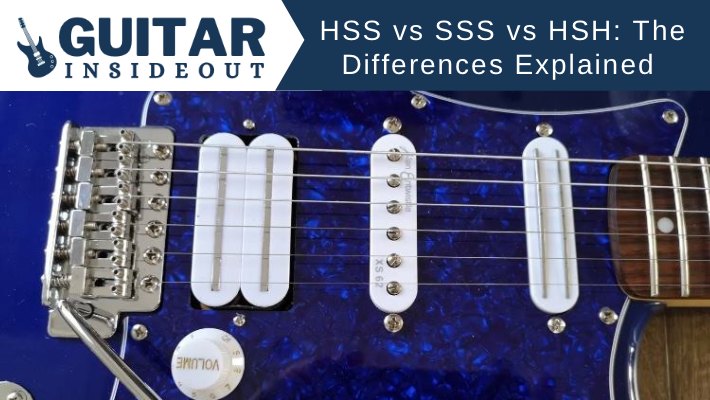
So if you want to know the differences between HSS vs SSS vs HSH then keep reading. We’ll outline what each means, how they compare and what sort of music they are best for.
Guitar Pickups Explained
Before we get into the nitty gritty of HSS, SSS and HSH we need to talk a bit about pickups. If you’re already familiar with the basics of guitar pickups you can skip this section.
So, electric guitars have pickups that take the vibrations when you strum or pluck the strings and create an electrical signal. That signal is sent through a cable to the amplifier which amplifies it (duh!) as a sound wave. That’s what we then hear.
There are two main types of pickups found in electric guitars: single-coils and humbuckers. There is a third type, P90’s, but when talking about HSS, SSS and HSH we aren’t going to need to know about them.
Guitars come with various pickup configurations – 1, 2 and 3 pickups, some with all of the same pickup type and some with a mix.
For example: A Gibson Les Paul Junior has only one pickup, a humbucker located near to the bridge.
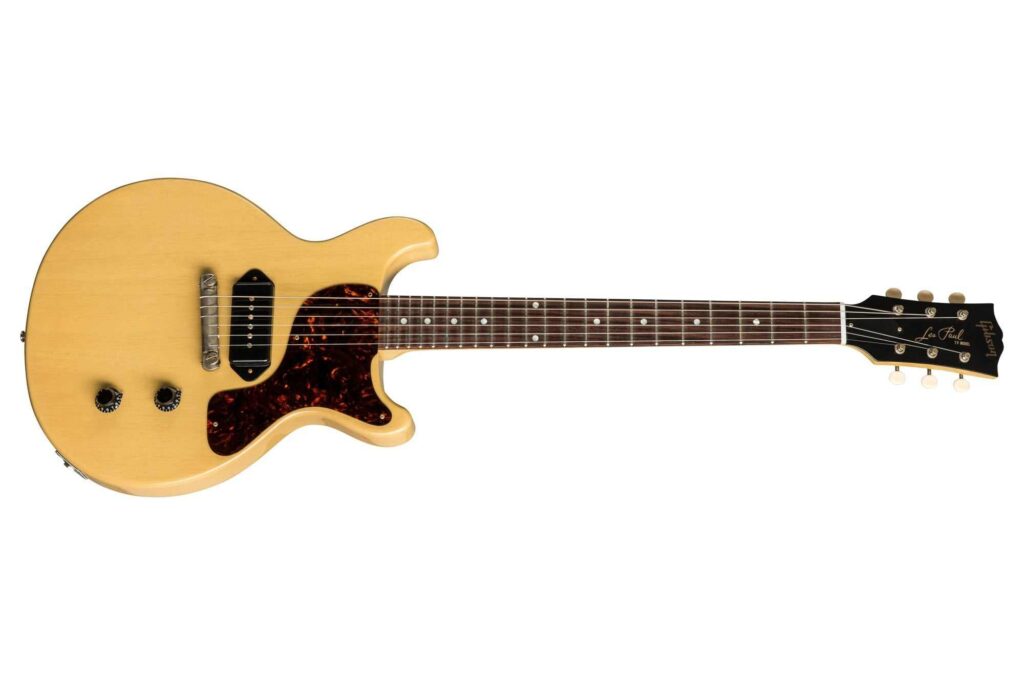
A Fender Stratocaster has 3 single-coil pickups located at the bridge, in the middle and near the neck.

An Ibanez RG550 has 3 pickups, 2 humbuckers and 1 single-coil. The humbuckers are at the bridge and neck with the single-coil in the middle.
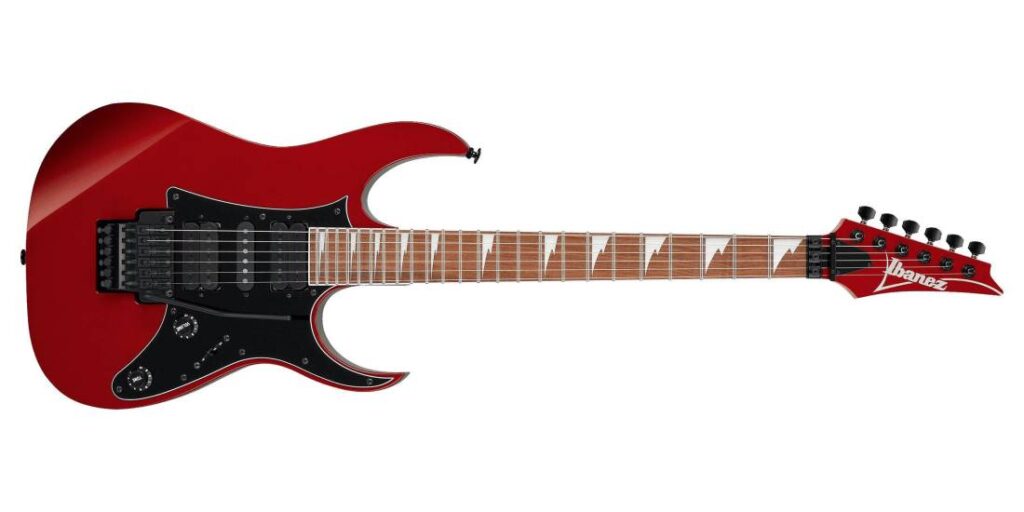
You can identify different pickups by how they look and the differences in how they sound.
Single Coils
Single-coils are thin bars with six metal dots or circles. Those circles are magnets.
A single-coil has a bright and twangy type of sound but are prone to picking up electromagnetic interference, also called the ’50/60Hz hum’.

Humbuckers
Humbuckers are noticeably thicker and look like 2 single-coils placed next to one another (humbuckers also come with covers which may make them look different).
Humbuckers have a much fuller, thicker sound with greater sustain. They also cancel out the hum that single-coil pickups create – hence the name ‘hum buckers’.

Selecting Pickups
Electric guitars come with pickup selector switches (the exception being guitars with only one pickup) that allows you to switch between the 2 or 3 pickups and even mix them together.
So you could engage just the bridge pickup or just the neck pickup. Or you could engage them both and use the two together. Or if you had a guitar with two humbuckers and one single-coil you could engage one of those humbuckers with the single-coil to get a combination of their two different tones.
Most pickup selector switches have either 3 or 5 different settings, depending on how many pickups the guitar has.
The 3 settings on 2 pickup guitars are:
- Bridge – Bridge pickup only.
- Neck and Bridge / Middle – If it’s a 2 pickup configuration then the neck and bridge pickup are active together. If it’s a 3 pickup configuration then it’s just the middle pickup active.
- Neck – Neck pickup only.
The 5 settings on 3 pickup guitars are:
- Bridge Only – Just the bridge pickup.
- Bridge and Middle – The bridge and neck pickups are both active.
- Middle Only – Middle pickup only.
- Middle and Neck – The middle and neck pickup are both active.
- Neck Only – Neck pickup only.
So we’ve looked at what pickups are and the different configurations of them you get in guitars.
What Do HSS, SSS and HSH Mean?
Now we need to establish what each of these acronyms actually means and stands for. Each of the 3 letters refers to the type of pickup and the order they are in from the bridge to the neck.
HSS
HSS stands for humbucker, single-coil, single-coil. The first letter, H, refers to a humbucker pickup and as it’s the first it’s the pickup nearest to the bridge. The 2 S’s refer to single coil pickups and so you have a single coil in the middle and neck position.

SSS
SSS stands for single-coil, single-coil, single-coil. From the bridge to the neck position every pickup is a single-coil.
This pickup configuration is most famously found in Stratocasters.
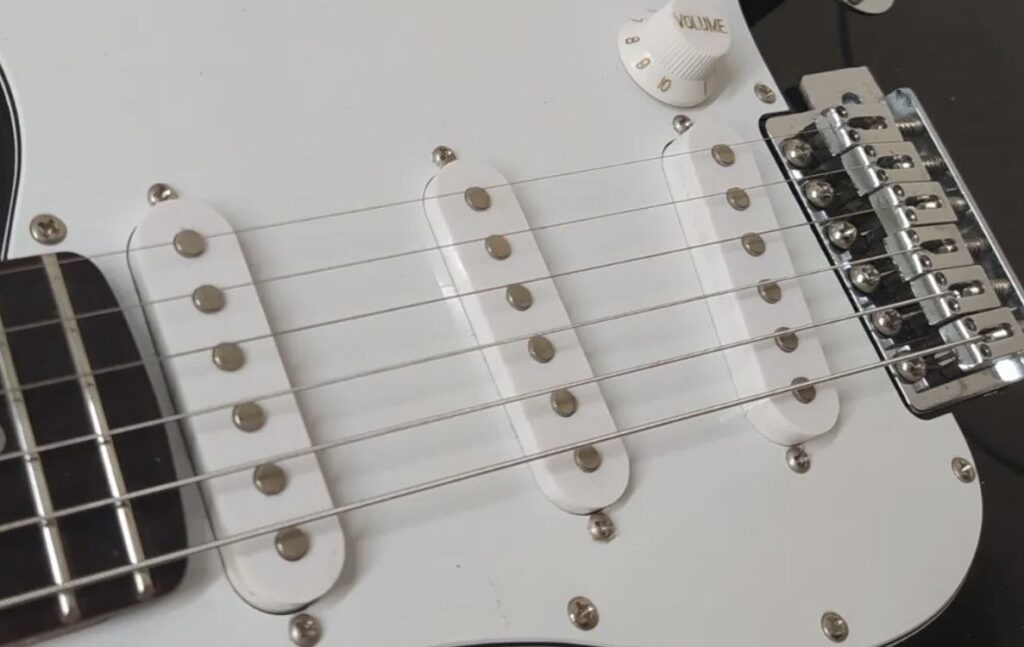
HSH
HSH stands for humbucker, single-coil, humbucker. So a humbucker in the bridge position, a single-coil in the middle and another humbucker at the neck.
This is probably the least common configuration. Many Ibanez guitars and superstrats have HSH configurations.
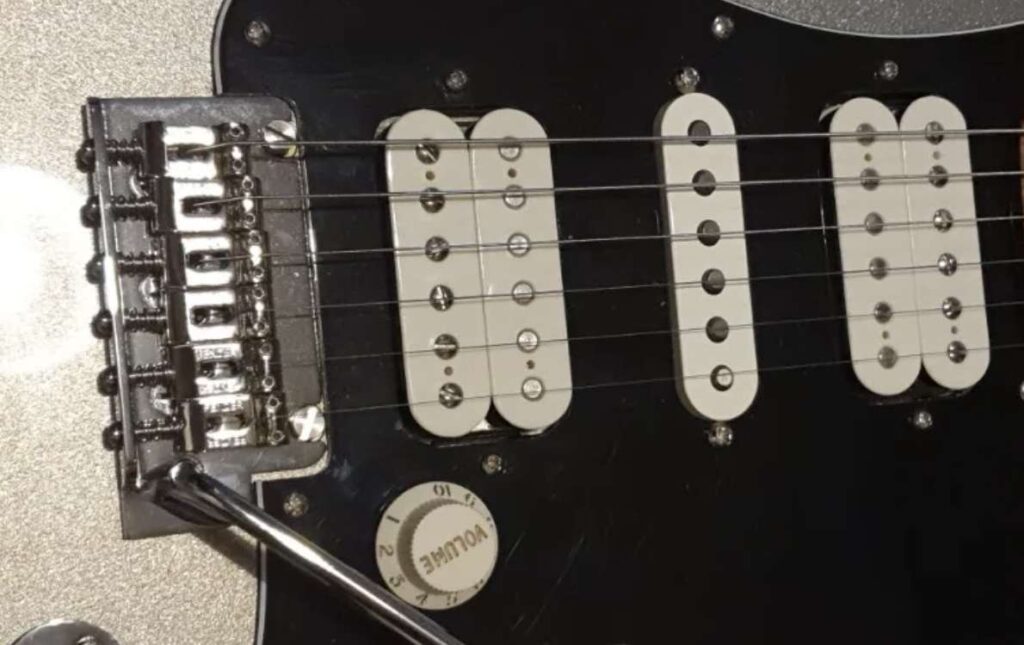
What are the Differences Between HSS vs SSS vs HSH
The main differences between HSS vs SSS vs HSH is the versatility of tones and sounds you have available. Having a mix of humbuckers and single-coil pickups in different positions gives you the chance to switch the tone your guitar produces and create more interesting and varied sounds.
If you stick to just one humbucker or one single-coil you won’t have much variety – everything will sound similar. But with the potential of 3 pickups, in different configurations, you can shape and alter your sound.
Being able to switch between a single-coil and humbucker allows for more variation of tones and to add extra dynamics to your playing.
And pickups in different positions have unique sounds. A humbucker located at the neck will sound different to one at the bridge. The same goes for single-coils too.
So why many people prefer one configuration over the other is that it suits the style of music they play. But for some simplicity is desirable, which is why single pickup guitars exist.
Pro’s of Each Pickup Configuration
Each set of configurations have their positives and negatives. Let’s take a look at them.
Advantages of HSS
Arguably the most versatile of all the pickup configurations, HSS gives you the best of both worlds. The humbucker in the bridge is ideal for heavier music and using higher gain whilst the 2 single-coils give you brighter and trebly tones if you need or want them.
You can also combine the 2 different pickups, having a mix of humbucker and single-coil that takes the warmth and fullness of the humbucker with the brightness of the single-coil.
Advantages of SSS
The only difference between HSS vs SSS is the humbucker at the bridge. The SSS configuration has a bridge single-coil pickup instead, everything else is identical.
So it comes down to whether you prefer the sound of a single-coil or humbucker at the bridge. SSS is the traditional and classic Stratocaster setup, so if you want Strat tones then that’s the way to go.
If you’re playing predominantly clean styles of music – pop, funk, R&B, country etc. then the single-coil at the bridge is going to be the perfect choice. Heavier rock and metal however is definitely going to sound better with a humbucker.
Advantages of HSH
As there aren’t that many HSH guitars you don’t find many comparisons of HSH vs HSH or SSS. But its definitely an interesting configuration that has it’s place.
A humbucker at the bridge and neck isn’t by itself particularly revolutionary. Les Paul’s have been doing that since the 1950’s.
But when you introduce a single coil in the middle position then it opens up your options. Essentially you’re getting a dual humbucker guitar that can also do a decent imitation of a Strat type sound.
The 2 humbuckers are going to be ideal for distorted and heavy tones. Add the middle single coil into the mix and you can let it brighten both the bridge and neck pickups or use is standalone to mimic a Strat.
In fact HSH guitars have become fairly synonymous with metal. It’s the reason you see a lot of Ibanez’s with this configuration.
Why? Because a lot of types of metal make use of very heavy distortion but break it up with chiming cleans. A full on metal track might be all heavy, distorted riffs until it reaches the bridge whereby it does a full 180 degree turn and goes very quiet and clean (before launching back into the distortion again).
So being able to switch between the humbuckers for high gain and the single-coil in the middle for cleans is beneficial for certain types and styles of music.
Con’s of Each Pickup Configuration
Disadvantages of HSS
The lack of a single-coil at the bridge might be an issue. It’s somewhat of an acquired taste – too thin and lacking for some but to others it’s just the sort of sound they want.
Also if you ever get a standard Les Paul or PRS then it might make an HSS Fender redundant. A Strat or Tele with a humbucker will do a good impression of a Les Paul but won’t totally nail it. So if you want that sound you might be better off getting the Les Paul and having a standard SSS Strat or SS Tele alongside it rather than trying to get everything from one guitar.
There’s also the loss of the 2nd position where the bridge and middle pickups are active in an HSS configuration. Those in between positions in a Strat – the bridge and middle or middle and neck – are so distinctive they’ve even got their own nickname: the ‘Quack’.
And depending on what sort of music you play you might also prefer having a humbucker at the neck.
So as good as HSS is it’s not completely perfect.
Disadvantages of SSS
The major downside to the SSS configuration is that the single-coil at the bridge can be too thin and weak sounding. You can of course replace it with a higher output pickup but why not just get an HSS or standard two humbucker guitar if that’s a concern?
On the flip side though you might find that a regular HH configured 2 humbucker guitar does everything that an HSS or HSH guitar does. In which case you might miss the SSS configuration and classic Strat tone you get from it.
Disadvantages of HSH
Much like the HSS the loss of the single-coil at the bridge might not be the sound you’re looking for.
But also losing the single-coil neck pickup takes away a big part of the classic tone of guitars like Strat’s and Tele’s. Many people, especially when it comes to Strats, love that neck pickup. It’s a fundamental part of the sound.
And again, as with HSS guitars, losing the middle positions can be too much of a compromise.
What About HH?
Another very common configuration is HH. HH stands for ‘humbucker humbucker’ – 2 humbuckers, one at the bridge and one at the neck. This is the classic setup for Gibson Les Paul’s and other similar guitars like PRS’s.
HH is much more popular for playing specifically heavier styles of music which single-coils are less suited to due to the high levels of distortion used. If you’re playing music that doesn’t ever need a clean tone then HH makes a lot more sense.
Example Guitars of Each Configuration
HSS Superstrats
HSS guitars are often referred to as ‘Superstrats’. Fender do a few HSS type Strats. The HSS American Performer is a wonderful example of an HSS guitar that suits all styles of music.
Alternatively Squier do the entry level HSS Bullet Strat or the very well thought of Classic Vibe 70’s Stratocaster for more affordable options.
There are many companies other than Fender that do HSS guitars though. Ibanez are well known for superstrats and the RG series are well established guitars that have been favored by some top guitarists for decades.
Charvel, owned by Fender, also specialize in superstrats. The Charvel Pro-Mod DK24 is a fantastic alternative to a Strat.
And if you’ve got cash to splash then something like a Suhr Classic S is a quality instrument.

SSS Stratocaster
The Fender Stratocaster is probably the most well known guitar. Whilst it comes in different pickup configurations the 3 single-coil version is the classic Strat sound everyone knows and likes.
The Fender Player Strat is a great example of a mid range Stratocaster. Squier of course do their own versions with the Affinity Strat having a special play in my heart as it’s what I learned to play on. The Classic Vibe 60’s Strat is a step up from Affinity but still very reasonably priced.

HSH Stratocasters
While there are fewer choices for HSH guitars there are still some great options. Some of Fender’s big ranges come in HSH configurations. The HSH Player Strat is an affordable way to try out an HSH guitar.

The Ibanez RG450DX is another in the RG series that performs far better than its price.
And Charvel have lot of HSH options, the Pro-Mod So-Cal Style 1 HSH arguably the pick of them all.

Which is Best: HSS, SSS or HSH
You can’t really proclaim one pickup configuration better than the rest. They all do different things and suit different styles of music.
As is so often the case when it comes to guitars it’s all about personal preference. From my perspective I like having one guitar that’s either SSS or SS – basically a Strat or a Tele, and then one with a humbucker in the bridge, usually an HSS configuration. I’m also a very keen on simplicity when it comes to playing the guitar so am constantly tempted by single pickup setup like a Les Paul Junior of Fender Esquire.
If forced to choose only one configuration though then I’d pick HSS. While it has it’s disadvantages (as mentioned above) I still believe it has the most versatility and covers the most out of the three.
But that’s what suits me. If you only play heavy music then an HSS or HSH is definitely going to better than SSS. For jazz HSH is probably the way to go. R&B, funk and country is almost exclusively played on single-coils.
So the style of music you’re playing and what you like are far more important than which is considers the best.
FAQ
Can you Put SSS in HSS?
Converting an SSS strat into an HSS configuration isn’t straightforward. SSS guitars aren’t usually routed for humbucker pickups, only single-coils.
So it would require you routing the body for a humbucker in the bridge position, not something a beginner should try. A luthier wouldn’t have any problem doing it but it would require some woodworking and if you aren’t confident it’s best not to try yourself in case you ruin your guitar.
Is HSS Good for Metal?
Yes, absolutely. HSS is a configuration often played by metal guitarists and the humbucker in the bridge will be more than good enough for heavier styles.
When was the First HSS Stratocaster Made?
The first official Fender HSS Strat was the made in Japan ‘Contemporary Stratocaster’ that was released in 1984. Other non Fender Strats were produced before that however in the 1970’s.
Who Uses HSS Strats?
HSS configurations aren’t that popular amongst famous musicians. Probably because they have the means to switch between an SSS style Strat and humbucker equipped guitar. But there are a few worth mentioning:
- Richie Sambora of Bon Jovi.
- Gavin Rossdale of Bush.
- Rob Harris of Jamiroquai.
- Mark Knopfler of Dire Straits.
- Adrian Smith of Iron Maiden (used Jackson’s now but had an HSS Strat for years.
- Ian Thornley of Big Wreck.
Conclusion
Choosing the pickup configuration in a guitar is actually very important. Along with the amplifier pickups play the biggest role in your tone. So getting it right for the type of music you want to play or sounds you want to create is crucial.
Hopefully this guide has shone some light on the differences between HSS vs SSS vs HSH and helped with choosing which is the best for you.


Very good information.
Thanks!
Just the info I was looking for. Thanks.